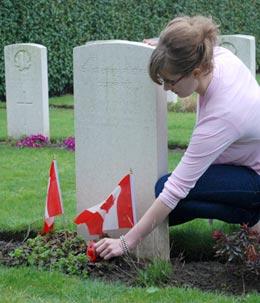Remembering Sikh-Canadian soldiers

Sunta Goojar Singh was the first Sikh to die for Canada in the Great War, but his headstone in a rural cemetery outside Ypres is the only Canadian one without a maple leaf engraved on it. At the outset of the war, most of the men who enlisted were immigrants -- most obviously the British who felt a strong tie to the homeland. But there were people from many backgrounds, both new and old to Canada. Among them were 10 Sikhs.
The Sikh population in Canada was small at the outset of WWI, dropping from 5,000 in 1907 to fewer than a couple of thousand by wartime, largely because restrictions made immigration difficult. Those who were successful usually landed in Vancouver, though many were turned away — most famously, the ship Komagata Maru was denied entry into Vancouver in 1914 because of racist exclusion laws.
Goojar Singh was born in Lahore, Punjab in 1881 and signed up for service in Montreal. On his attestation papers, “complexion” has been crossed out and a word that looks like “caste” is written in its place: “Rugepoot. E. Indian,” which is perhaps a bungled and erroneous interpretation of a “Sikh.”
“The Sikh community has had a long-standing military tradition,” says Pardeep Singh Nagra, the executive director of Sikh Heritage Museum of Canada, noting that photos of early Sikh pioneers in Canada show them wearing military medals. Goojar Singh had been a member of the Punjab Rifles for three years before he came to Canada.
La Laiterie Cemetery is a regimental cemetery and Goojar Singh’s grave is in the area farthest from the road, under a grove of trees, on the sloping land where the Victoria Rifles buried their men.
According to the battalion diary, they finished their tour of nearby trenches on Oct. 4, 1915, with an enemy that was fairly active with “sniping and artillery.” While they were resting in billets, working parties were sent to rebuild trenches, day and night. Goojar Singh was likely involved in this work; he was killed in action on October 19.
The bureaucracy wasn’t sure how to classify Goojar Singh in life or death.
On the enlistment papers he belongs to the Church of England, on a death certificate he is Buddhist. At the cemetery, he is listed under “Gougersing” in the registry. His headstone is engraved with Gurmukhi (the Punjabi script) that translates as “God is one” and “Victory to God.”
There are no photos of Goojar Singh, no letters. The museum does have a letter from another Sikh, Waryam Singh, describing fighting on the Somme in November 1916, where shells and bullets fell like rain and “one’s body trembled to see what was going on.”
“We went over like men walking in a procession at a fair and shouting we seized the trench and took the enemy prisoners. I didn’t think of our safety at all but felt that the Guru Maharaj was fighting in me. He is great and it is thanks to Him that I was able to do all I did … The bravery which we showed that day was the admiration of the British soldiers. After the fight they asked me how it was that I was so utterly regardless of danger,” he wrote.
Original story by Katie Daubs, published by The Toronto Star.
Leave a comment









